Severity of Atlantic Declines, Their Causes and
What Needs to be Done.
Here are the Facts.
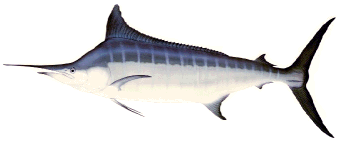
![]()
New Article - "Atlantic Hot Spots"
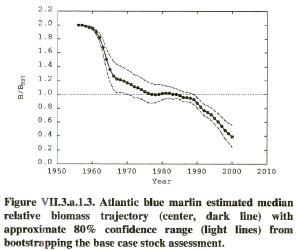
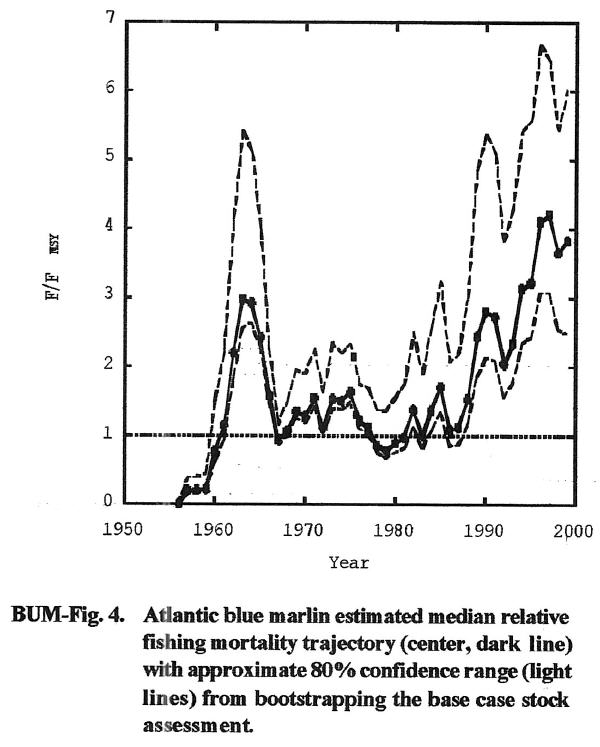
Sustainable Level (1.0)
As shown in the ICCAT figure above right, the cause of this decline in abundance is excessive fishing pressure by commercial fishing fleets (primarily longlines).� By 2000, it had grown to 4 times higher than the sustainable level or MSY (indicated by the dashed line at 1.0).� A responsible fishery manager would never allow fishing mortality to remain above the level that would produce the MSY.
White marlin are found only in the Atlantic Ocean, while blue marlin (like swordfish) inhabit not only the Atlantic but also the Pacific and Indian Oceans. For stock assessment purposes, both Atlantic blue marlin and white marlin have recently been treated by the scientists
conducting stock assessments and advising ICCAT as single interbreeding stocks throughout their entire Atlantic Ocean range.� In the past, ICCAT's scientists assessed both the North and South Atlantic sub-populations separately, and they continue to do this for swordfish. However, for the reasons specified below and in our pages devoted to their "hot spots" - see links below - we are convinced that there are separate, non-interbreeding sub-populations of both Atlantic marlin species above and below the Equator. This is an important distinction since recovery of the North Atlantic sub-populations of white and blue marlin (and swordfish) is in no way dependent on obtaining reductions of commercial fishing pressure in the South Atlantic.
(The same is true of bluefin tuna populations. "Ours" spawns in the
Gulf of Mexico; the eastern population spawns in the Mediterranean.)
Both Atlantic marlin species are caught and retained by all industrial fishing fleets, except those of the United States (whose commercial vessels are required to release all billfish) where billfish are reserved exclusively for the recreational fishery
(which voluntarily practices catch and release and is responsible for only 0.03%
of the the annual mortality above the Equator).� However, about 25% of blue marlin and 30% of white marlin caught on longlines are already dead on arrival at the vessel.�
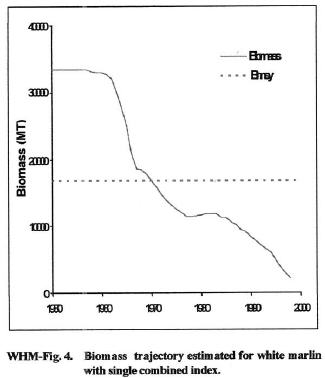
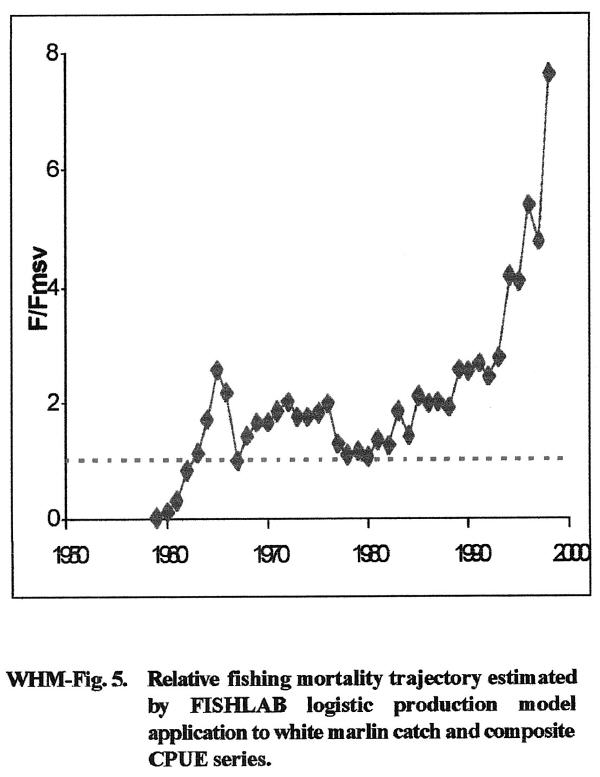
<
8 times the
Sustainable
Level (depicted as the dotted line at1.0)
At this rate of decline, Atlantic white marlin will become functionally extinct (unable to sustain a viable breeding population) in less than 5 years and blue marlin in perhaps 10 years!
Fishery biologists know that the abundance of a population under proper management should never drop below the MSY level and should remain well above it, if it is to also provide sufficient numbers and larger fish to support a quality recreational fishery and to provide enough large fish to maintain essential predator-prey balance (as required by the Sustainable Fisheries Act's new "optimum yield" definition).�
The kill caused by fishing - called fishing mortality - has increased dramatically.� For white marlin it has reached 8 times the sustainable level and it appears to be accelerating higher.� For blue marlin, fishing pressure has reached 4 times greater than the long-term sustainable level.� Fishing pressure should never be allowed to exceed the MSY level (1.0) for a population that has been seriously depleted, such as these.� Maps showing the locations where U.S. longline vessels catch the greatest numbers of North Atlantic marlin (as well as sailfish and swordfish) can be seen by clicking the links (in red) entitled "Hot Spots" located near the bottom of this page.� These maps depict primary spawning and feeding areas by quarter for both 1994 and 1995.
Consequently, both blue marlin and white marlin stocks are continuing to decline rapidly.� They are also rapidly approaching extinction (the zero line).� Their populations are both well below the level at which there is a danger of recruitment failure (considered for these species to be at 50% of MSY).� Passing such a threshold means there are too few adult breeders to replace the population, which can then spiral ever faster towards extinction.� Since the commercial vessels are targeting other species whose populations are stronger, the kill of marlin will continue until it becomes unprofitable to target swordfish and the larger tunas.� Yellowfin tuna, for example, are estimated to still be at the MSY abundance level, and thus they can withstand a great deal more commercial fishing pressure.� Since 30% of all white marlin and 25% of the blue marlin caught on longlines arrive at the vessel dead, this kill will continue as long as commercial vessels fish in these species' primary spawning areas and feeding grounds (their "hot spots"). The two Atlantic marlin species will not be able to survive the continued pressure targeting swordfish and tunas.� They are already too close to the brink of extinction. This information has been provided on an annual basis to those responsible for managing and conserving these fishery resources - ICCAT and NMFS.�
Commercial vessels (longlines, gillnets and purse seines) are responsible for 99% of the reported kill of Atlantic blue and white marlin.� Recreational fishermen, who voluntarily release a self-reported 99% of their catch to help conserve the resource, are responsible for less than 1% of the annual fishing mortality.
ICCAT finally recognized the problem and adopted a requirement that member nations limit their landings of blue marlin and white marlin to 50% and 67%, respectively, of their 1999 landings. This provision was to begin June 1, 2001. If all member nations were to comply fully, the overall fishing mortality rate for Atlantic white marlin can be reduced from 8 times the sustainable rate (as shown in the graph above) to, at best, 2.6 times higher than the sustainable rate (8 x 0.33). This is still much too high. While better late than never, ICCAT's new requirement will at best only slow but not stop or reverse the white marlin's rapid decline toward extinction. For Atlantic blue marlin, the new requirement will do the same thing (reduce the fishing mortality rate from 4 times too high to 2 times too high). Thus, it will slow but not reverse the steady decline toward extinction. And since 30% of all white marlin and 25% of all blue marlin caught on longlines arrive at the vessel dead (regardless of whether they were to be retained or discarded), this additional kill will continue as long as these commercial vessels are allowed to fish (even for other target species) in the marlin's primary spawning areas or feeding grounds.
However, ICCAT's management
measures have not stopped the decline. Shown below is the total
reported Atlantic-wide catch of both blue and white marlin between 1990 and
2007 (from ICCAT's latest - 2006 - stock assessment report). The marlin are
caught incidentally on longlines targeting the "money fish" (bluefin tuna,
swordfish, bigeye tuna and yellowfin tuna) and are often dumped overboard
dead or dying to make room for the more valuable species. The
catch of blue marlin (BUM) continues to decline because the population
continues to decline in abundance as a result of this continued collateral
mortality. They will continue to be caught and killed as long as the
fishery targets tunas and swordfish. As shown below, the Atlantic blue
marlin population has now declined from 20% of its unfished (1960) abundance
in 2000 (as portrayed in the figure at the top of this page) to just 10% of
its virgin biomass by 2007, and it appears to still be declining.
However, the decline of the Atlantic white marlin population is much
worse and more serious. We filed a
petition in 2001
(based on catch data through 1999, as depicted above) to have the species
"listed" as "threatened or endangered" and then protected under the
Endangered Species Act. We did this because by 1999, its
population had declined to just 6% of an unfished (1960) level of abundance
and it had been declining at a rate of 2% per year for over a decade (see
figure above).
NMFS adopted the position that it was not at "risk of extinction" (the
definition of "endangered") until its population reached 1% of its original
abundance (K in modelers' terminology). As can be seen in the figure below, the total reported
Atlantic-wide landings continues to slide toward zero and by 2007 it had
reached about 2% of its original "virgin" abundance. In our judgment,
extinction is imminent.
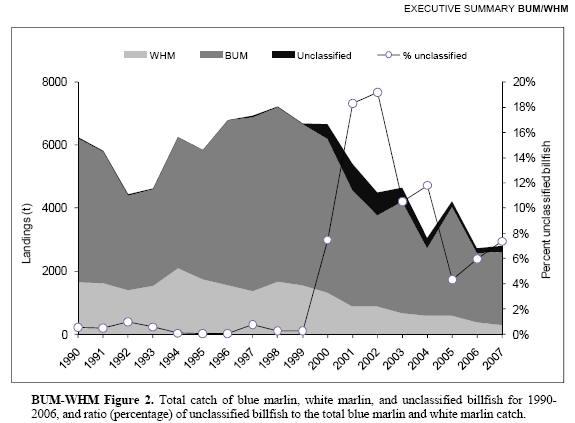
ICCAT's 2012 Preliminary Stock Assessment Results
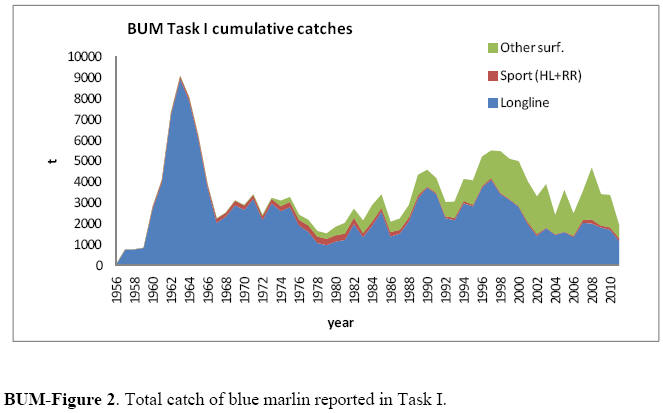
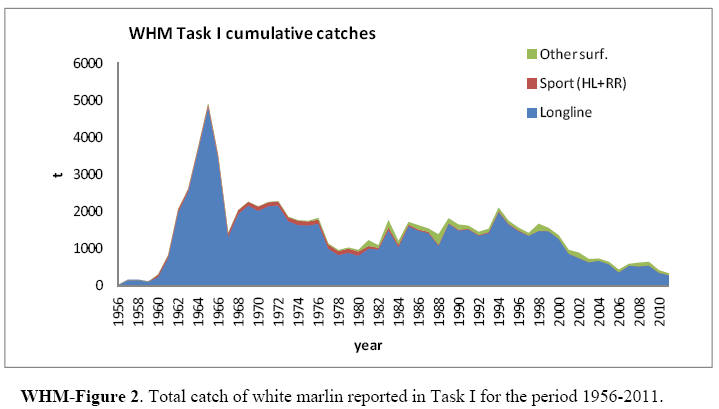
Below - the blue line represents total Atlantic blue marlin biomass decline; red line represents its cause - excessive fishing pressure.
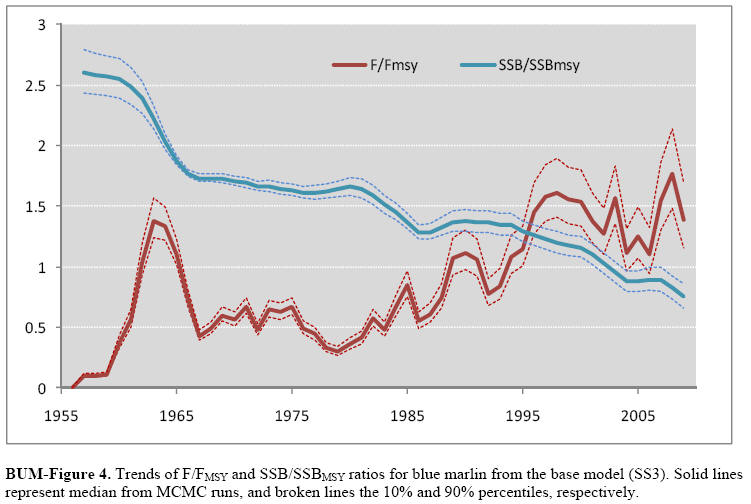
Below - total Atlantic white marlin biomass decline in red and fishing pressure in blue (1955 thru 2011).
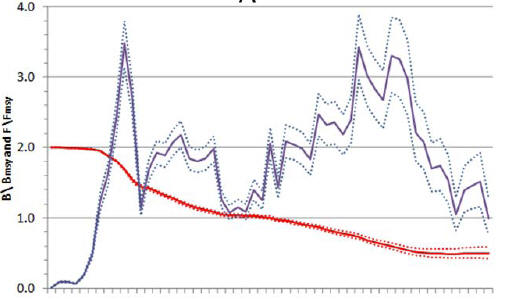
WHAT
IMMEDIATE ACTION IS NEEDED? -- CLOSE THE "HOT SPOTS" TO LONGLINES
We refer to the white marlin's (and blue marlin's) critical habitats - their primary spawning sites and feeding grounds - as their "hot spots." These small, distinct areas are used year-after-year. They have been mapped based on 10 years of U.S. longline catch records reported to NMFS. To see the locations of their prime spawning sites and feeding areas, click on the links below entitled "Hot Spots" of White and Blue Marlin.
To see the specific areas under U.S. jurisdiction that we have
recommended for closure to longlines, click
here.
These "hot spots" are not just the areas where the longliners fish most heavily. As can be seen in the following plots showing the yearly extent of U.S. longline vessels' sets (1992, 1995, 1996 and 1997), longliners are covering a much greater area of the North Atlantic than just the area of these "hot spots." In fact, we estimate that closing all the white marlin's "hot spots" in the North Atlantic would deny U.S. longliners access to only about 2% of the area they normally fish. But, it would eliminate about 85% of their interactions with white marlin. Obtaining these closures and reducing the kill of white marlin accordingly is the primary objective of our ESA Petition. It requests that the U.S. government first "list" the white marlin as either "threatened" or as "endangered" and then protect it and its critical habitats (its "hot spots") under authority of the Endangered Species Act (see link to the White Marlin ESA Petition below).
TWO SEPARATE POPULATIONS - ONE ON EACH SIDE OF THE EQUATOR
Obtaining closures in the North Atlantic "hot spots" is important because, based on all the information available, we are convinced that there is not one Atlantic-wide population of white marlin or blue marlin, but two - one in each hemisphere. The South Atlantic sub-populations of both blue and white marlin appear to spawn primarily off the northeast coast of Brazil (Royal Charlotte Bank area, a large submerged plateau much like Georges Bank off Massachusetts) during late spring-early summer in the southern hemisphere (probably peaking in November-early December). The North Atlantic sub-populations ("our" white and blue marlin) spawn in the Caribbean region during late spring-early summer (peaking from gonad examinations in May-early June). From the 10 years of longline catch records by quarter we know that it is most probably concentrated in the large gaps between the larger islands of the Caribbean (such as the Mona Passage between the Dominican Republic and Puerto Rico where large concentrations of larval white marlin have recently been found). Thus, spawning by the North and South Atlantic sub-populations of both white marlin and blue marlin occurs 6 months apart and the two centers of spawning activity are separated by 4,000 miles of ocean. Clearly (for both the white marlin and the blue marlin), these are not single Atlantic-wide populations, but two entirely distinct sub-populations which do not interbreed. The same is already accepted by the international scientific community for North and South Atlantic swordfish - 2 separate and distinct sub-populations, one in each hemisphere. Therefore, overfishing on one sub-population of any of these three species (swordfish, blue marlin or white marlin) will have absolutely no effect on the other sub-population. Shown below is the total reported catch of "our" white marlin from the North Atlantic between 1956 (when longlines were first introduced) and 2010 (source ICCAT's 2011 Stock Assessment). Total catch has declined by two thirds since 1999 when we filed our petition to have white marlin listed under the ESA. It was at 6% of an unfished population then and as shown below is now down to about 2% and marching steadily toward oblivion.
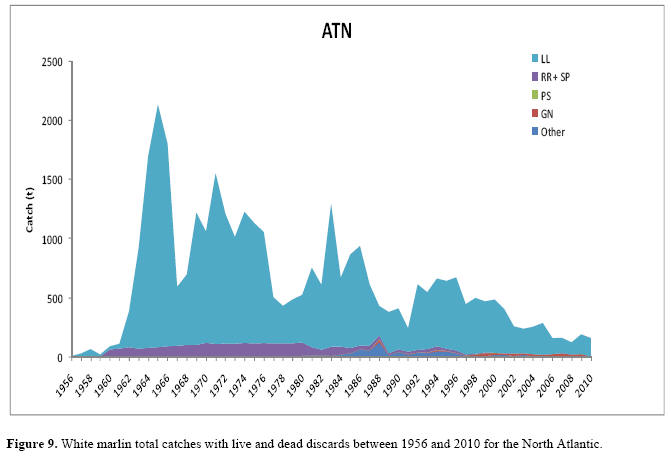
We may not be able to save white marlin or blue marlin of the South Atlantic because that is totally dependent on international agreements at ICCAT. But, the U.S. can unilaterally protect the North Atlantic sub-populations (of both marlins) to a great extent by prohibiting longlining in their "hot spots" that are located in U.S. waters. This is true simply because, except for spawning, most of the sub-population's members apparently spend a large part of their adult life in U.S. waters. This is particularly true of white marlin and less so for blue marlin and swordfish which range farther out into the mid-Atlantic (the site of the movie "The Perfect Storm") during summer through fall following (the edges of) the Gulf Stream. All three species, however, appear to use the same very small and distinct areas in the Caribbean region as their primary spawning sites. The most important "hot spots" are used at the same time of year and for the same purposes (both spawning and feeding) by not only the North Atlantic white marlin sub-population, but also the North Atlantic sub-populations of swordfish and blue marlin. So, closing them to longlines to protect white marlin will also markedly benefit blue marlin and swordfish as well.
Be sure to see the other sections of this website
(links in red below) for details on the population declines of each of the Atlantic Ocean's big fish.
THE PACIFIC SITUATION
The population status of Pacific marlin (black marlin, blue marlin and striped marlin), sailfish and the rare spearfish are not well documented.� But, commercial fishing effort is already high and escalating.� The situation in the Atlantic provides a stark example of what is probably also occurring in the Pacific.� It's just not being as well documented.
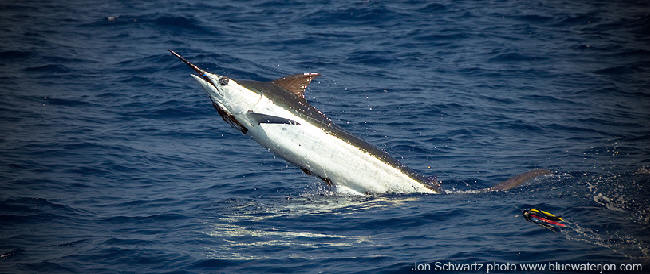
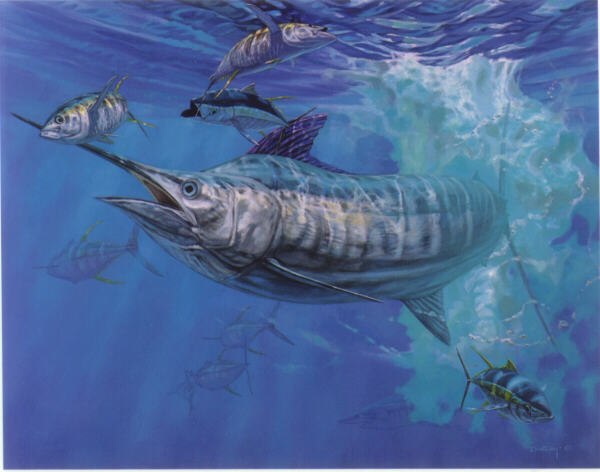
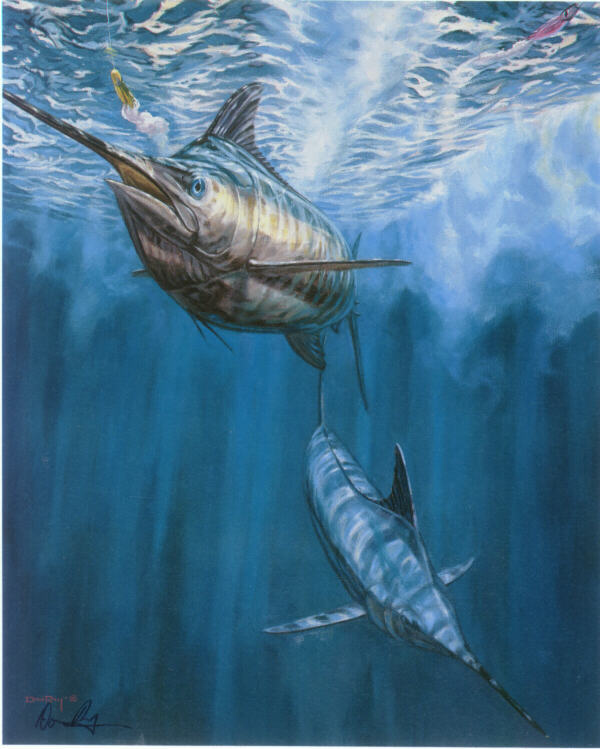
Primary Spawning and Feeding Area Maps
Blue Marlin
White Marlin
Sailfish
Bluefin Tuna
Swordfish
Congress' Longline Closures Bills
Will They Work?
Severity of Atlantic Population Declines
The Facts - Headed for Extinction
Bluefin Tuna
Swordfish
Sailfish
Sharks
Daily "Kill-o-Meter"
Endangered Species Act
White Marlin ESA Listing Petition
White Marlin "Hot Spots"
Blue Marlin "Hot Spots"
Bluefin Tuna ESA Listing Petition
Recommended Longline Closure Areas
Articles on Big Game Fish and Fishing
Overview and List
Photos of Big Game Fish
Largest Marlin, Bluefin, Many World Records
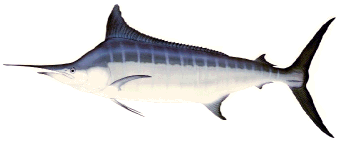
Chambers and Associates
9814 Kensington Parkway
Kensington, Maryland 20895
(T) (301) 949-7778�� (Fax) (301) 949-3003
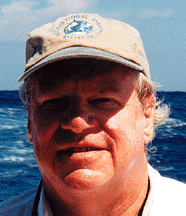
Jim Chambers
Chambers and Associates
Description
List of All Pages on this Website
Home